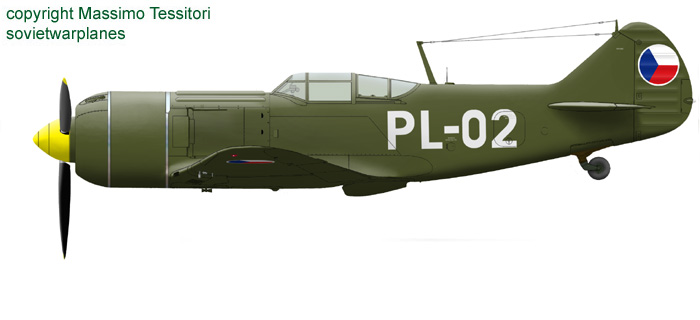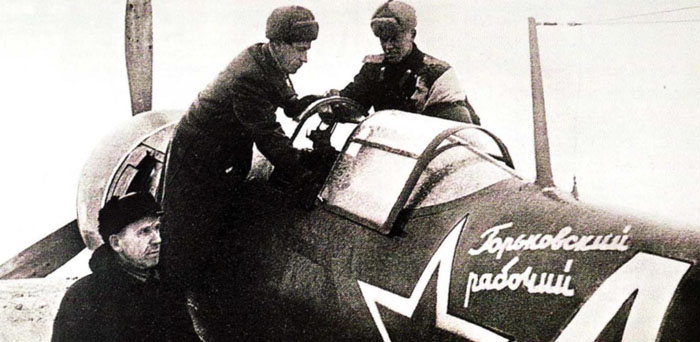
At first, 8 La-7s were delivered to the 1st Czechoslovak Fighter Regiment on 28 April 1945 in Poland, too late to take active part to war.
The photo shows (probably) La-7 n.49 with the inscription 'Gorkovskiy rabochiy' (workman of Gorkiy), built thanks to the donation of workmen of Gorkiy, perhaps photographed on the airfield of Zavod 21.
At least three planes (06, 49, 95) with the same slogan were delivered to Czech units.
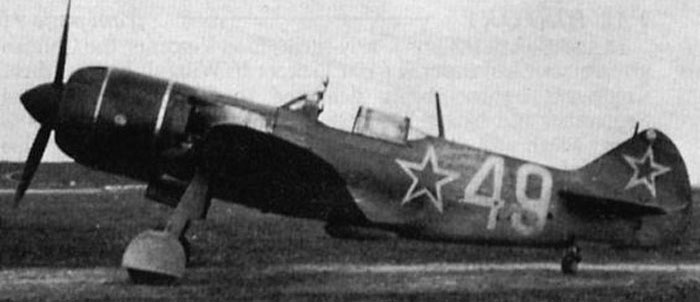
Plane 49 with the slogan 'Gorkovskiy rabochiy'.
The plane of the photo was probably one of the planes of the batch originally delivered to the 2nd Czech regiment and then given to the first regiment.
Its serial was 45210849 (La-7, built in Zavod 21, serie 08, plane 49).
The plane looks to have a protruding camera on its winshield, that was likely installed after its delivery to the unit.
Image from Lavockin La-7 of Milos Vestsik, MBI
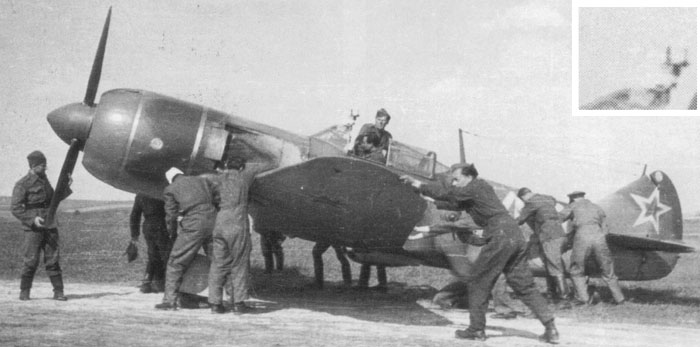
Another image of plane 49.
There is an enlarged detail of the supposed camera on the winshield.
On this photo, the spinner seems to be painted red.
Image from Lavockin La-7 of Milos Vestsik, MBI

A profile of 49 that puts into evidence the slogan and the supposed camera on the windshield.
Planes of 1st Regiment are said to had colored spinners:
- 1st squadon: white;
- 2nd squadron: red with a white base (long about 1/4 of the total length);
- 3rd squadron: probably red.
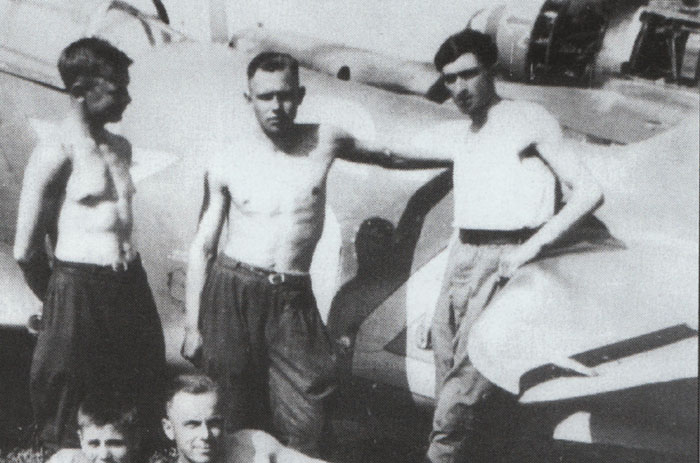
At the beginning of May 1945, more La-7s were delivered to the 2nd Czech Regiment, that gave 5 of them to the 1st Regiment.
In total, Czech AF received 56 La-7s. Their Czech designation was S-97 (S for Stihacka, fighter)
Aside: photo of plane 62 of 2nd Regiment in July 1945.
Czech La-7s of 2nd Regiment had still red star on, but the spinners were already with the Czech colors, and the white/red arrows on the cowlings were already in place.
A strange characteristic of this photo is that the braces of the red star behind the first mechanic are misaligned and too close; perhaps the photo has been badly restored by cloning a piece of a star from another image.
Image from Lavockin La-7 of Milos Vestsik, MBI
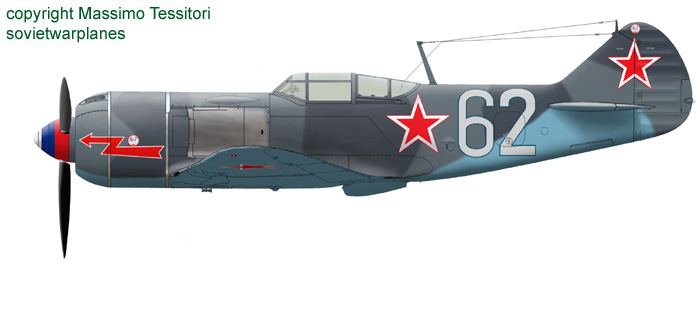

In August 1945, the planes were officially passed from the 2nd Soviet Air Force to the Czech Air Force, and received Czech roundels instead of red crosses.
Aside: plane 33 of 2nd Regiment in the Kbely Airport, near Prague.
At first, the original AMT-11/12 camouflage was preserved.
Note that the 'white' of the bort numbers was much darker than that of the Czech marks.
Image from Lavockin La-7 of Milos Vestsik, MBI
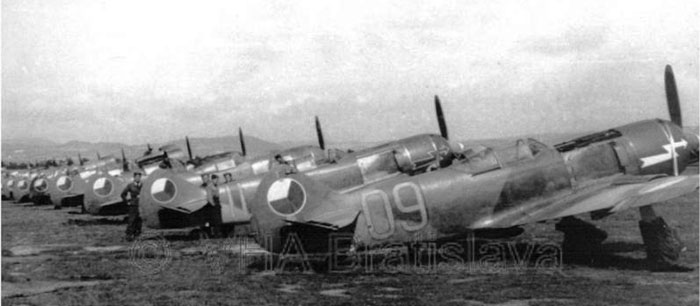
A line of Czech La-7s of 2nd Regiment on the Try Duby airport in summer 1946.
The planes seem still to have the original grey/grey camouflage, although faded and heavily retouched, particularly where the red stars were deleted. It seems that the stars were repainted with AMT-11.
Note that the Czech roundels were on the wings uppersurfaces too, differently from the Soviet stars.
The bort numbers can no be called 'white' any more; one can suppose that they turned to grey or cream because of aging.
Image from Lavockin La-7 of Milos Vestsik, MBI
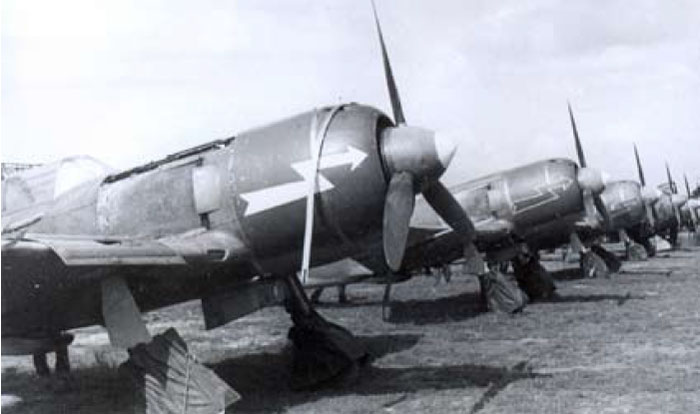
Planes 09 and 11 are probably the s/n 3810965 and 3811165, built in Z.381 and armed with 3 guns.
Aside to them, the Czech AF received other 3 3-guns La-7, serialled 3810565 (presumably 05), 3811465 (presumably 14) and 3812764 (presumably 27).
The lightnings on the noses can be white with blue outline or red with white outline; the latter seems to be the most common variant.
The spinner should be (from forward): white, blue, red.
Image from Lavockin La-7 of Milos Vestsik, MBI
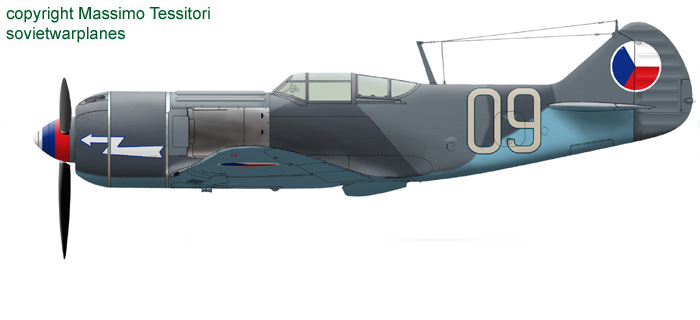
Profile of plane 09 of the photo above.
It is a 3-guns La-7 built in Zavod 381.
The number fonts of Z.381 were slightly thinner and more angular of those of Z.21-built planes.
When the plane had the red stars, those on the fuselage were particularly big on planes of Z.381; so the AMT-11 grey repainting on the sides protrudes on the light blue area.
The AMT-11 repaintings have deleted some of the dark grey AMT-12 bands, on the tail for example, while the nose seems all dark grey.
Note the absence of the La-7 logos.
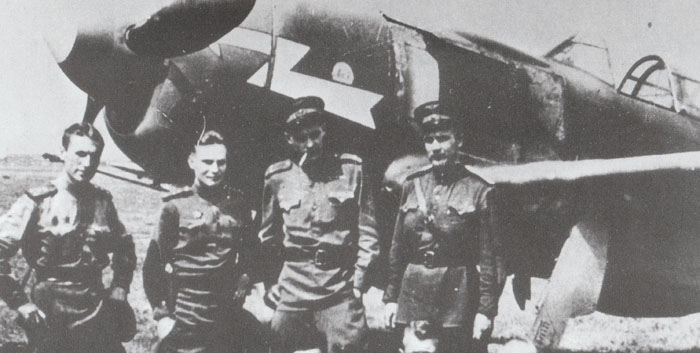
Another La-7 with a white bolt, probably with blue outline.
Being this a 2-guns La-7, distinguishable for the tapered shape of the gun fairing, it can't be the same as plane 09 of the photo above, that had 3 guns and linear fairings.
So, more planes of the 2nd Regiment had the white bolt with blue outline. It's not clear if this variation had any heraldic meaning.
Image from Lavockin La-7 of Milos Vestsik, MBI

Plane 11 of the 2nd Fighter Air Regiment, flown by Flt. Sgt. Stefan Ocvirk, presumably in late summer 1945 or in 1946.
The plane was photographed after a collapse of the left leg of the landing gear.
The camouflage is still the typical Soviet grey/grey one, and so the bort numbers anf La-7 logos.
Apart for the Czech marks, the red-white bolts and the three-colour spinner, the plane is characterized by a small '4' on its rudder and a dark stripe on the fin.
The plane looks to have the old arrangement of the aerial wire, entering on the right side of the canopy.
Image from Lavockin La-7 of Milos Vestsik, MBI
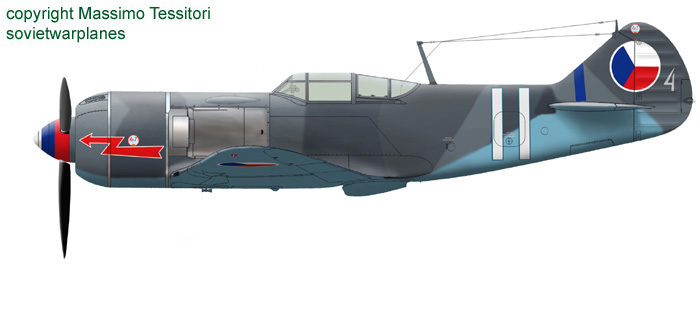
Profile of plane 11 as for the photo above.
The meaning of the dark line on the fin is unclear, here it wa drawn as on the MBI monograph.
Note the repainting there the original red stars were deleted.
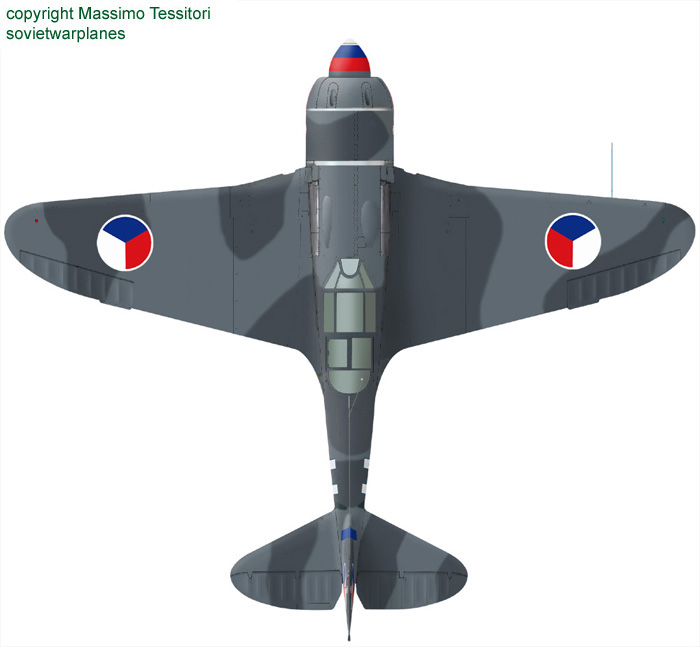

A major problem for the Czech Air Force was that the factory guaranteed only two years of life to the airframe of La-5s and La-7s, so, a joint Soviet-Czech commission examined all the Lavochkins in July 1946. They found traces of deterioration in the wooden fuselages and wing spars, and other defects; six La-7s were prevented to fly.
In Decenber, the Ministry of Defence banned the use of La-7 and sent two examples for tests at the Scientific Institute for Aircraft in Prague where they made stress tests.
Aside: image of plane 06(s/n 45210806) of 2nd Regiment during the stress tests.
Note a detail, a cover on a cooling slot on the metallic plate on the side.
Image from Lavockin La-7 of Milos Vestsik, MBI
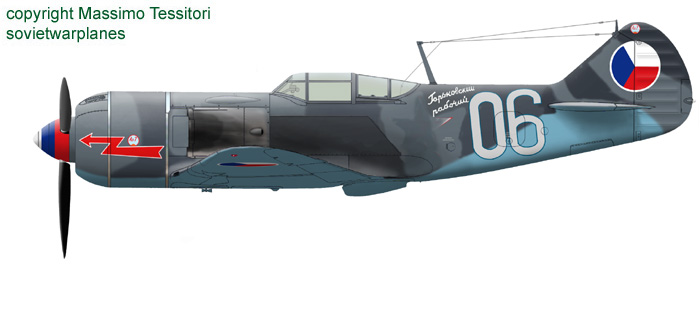
This profile represents the plane above when still serviceable in the 2nd Squadron.
The original grey/grey camouflage is still visible, as the red star on the fuselage through the paint that covers it.
Interestingly, the plane had the slogan 'Gorkovskiy rabochiy' of Soviet origin.

Aside: La-7 n.100 (s/n 452125100) during the stress tests.
The result of the stress tests was that, although the resistance has dropped below 50% of the original, the structure was still strong enough. So the type restart to be flown in 1947, being gradually withdrawn from service in the following years. Some of them remained operative up to 1950.
Image from Lavockin La-7 of Milos Vestsik, MBI
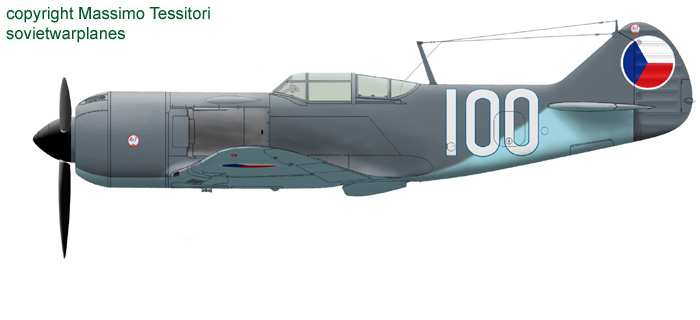
Aside: profile of the plane of the photo above, when still serviceable.
The plane belonged to 1st Regiment and had already the uniform blue-grey livery on the uppersurfaces instead of the Soviet grey/grey camouflage.
Tthe odd three digits number is, probably, still from the factory.
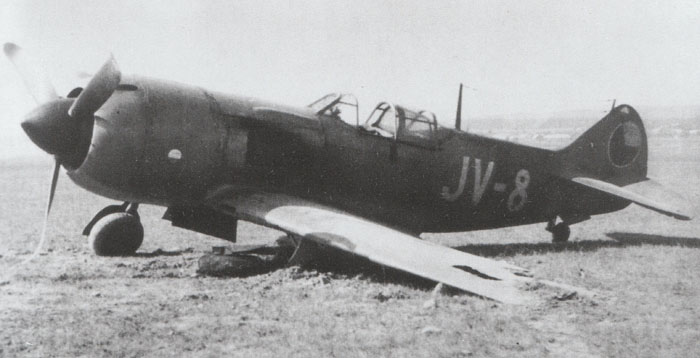
La-7 JV-8 of the 1st Air Regiment, 2nd squadron, photographed in Try Duby airfield near Zvolen on 8.9.1947. The pilot Flt. Sgt. Jan Kalisty went out of the runway during a landing.
The planes were repainted with uniform blue-grey uppersurfaces; on the rear fuselage, a darker repainting is visible, covering the original bort numbers that were changed after the overall repainting.
Image from Lavockin La-7 of Milos Vestsik, MBI
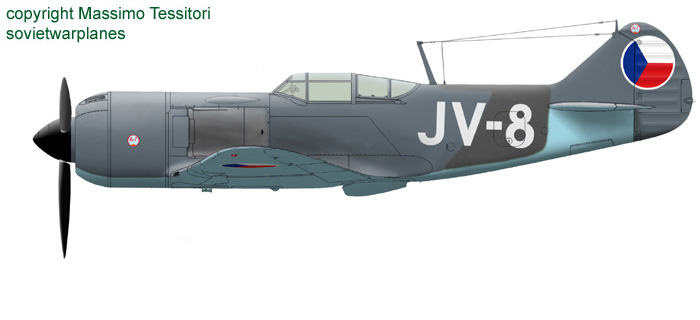
A profile of the plane of the photo above.
The black spinner marks the inclusion in the 4th Air Division.
The fuselage codes were related to the squadron within the 1st Regiment::
- commander's flight: CY
- 1st Squadron: IW
- 2nd Squadron: JV
- 3rd Squadron: KU

La-7s of 2nd Regiment preserved the colored spinners and the bolts even after the repainting with solid blue-grey uppersurfaces.
Note that the succession of colors on the spinner seems different plane to plane: both white-blue-red and white-red-blue spinners seem recognizable.
The fuselage codes were related to the squadron within the 2st Regiment::
- commander's flight: EW
- 1st Squadron: OP
- 2nd Squadron: GZ
- 3rd Squadron: HY
Note that the codes are repeated under the wings.
Image from Lavockin La-7 of Milos Vestsik, MBI
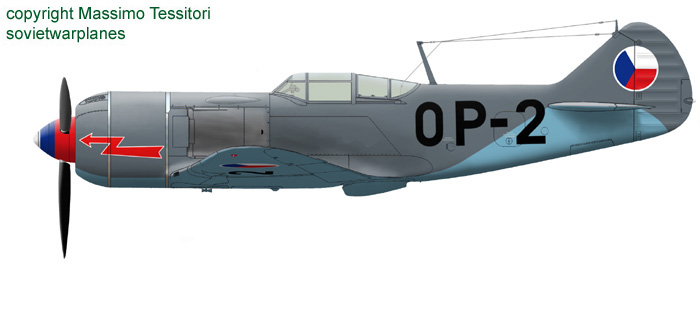
The profile depicts a plane of the 1st Squadron of 2nd Regiment, inspired to the photo above.
The number 2, not visible on the photo, is a guess.
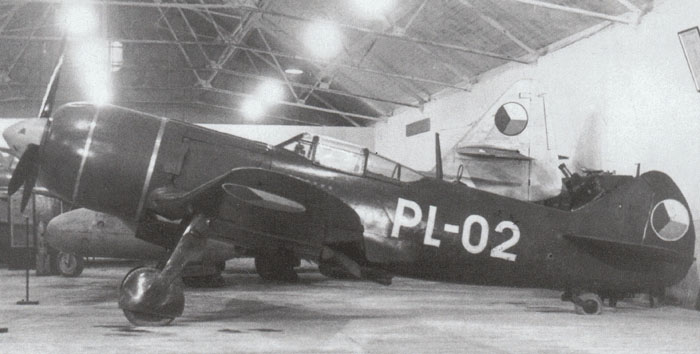
PL-02 was a three-guns La-7 that served with the 2nd Regiment with the black IW-9 code.
The photo shows how it appeared when utilized as instructional airframe at the Olomouc Military Air School. Code PL-02 denoted a ground training plane.
Note the loop aerial on the fuselage back, a postwar update.
The tail wheel seems to have become non-retractable, and its doors seems fixed in closed position and partially cutten.
Image from Lavockin La-7 of Milos Vestsik, MBI
